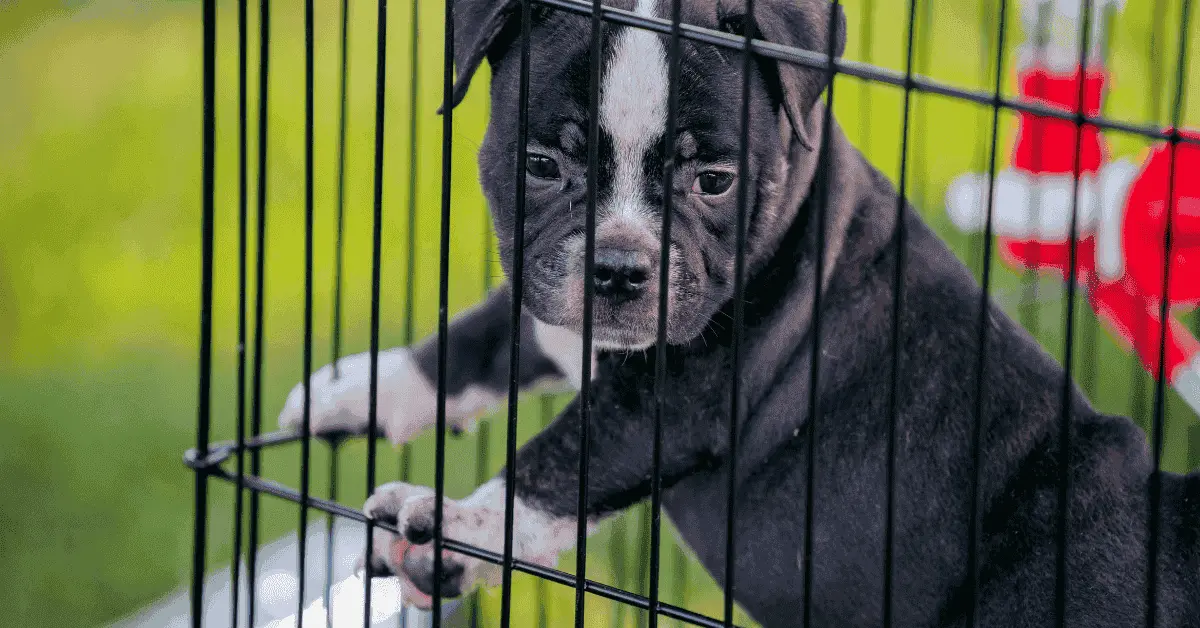Bringing a new puppy home is one of the most exciting milestones for any pet parent. As you embark on the journey of puppy training, cuddles, and new adventures, you might encounter a common challenge: a crying puppy in a crate. This behavior, though natural, can be distressing for both the puppy and the owner.
But don’t worry! Crying in a crate is a normal phase in the puppy’s adjustment period. Understanding the underlying causes of your puppy’s tears and knowing how to respond can make this transition smoother. In this comprehensive guide, we’ll share practical and effective methods to calm your puppy, soothe their separation anxiety, and help them adjust to crate training successfully.
Table of Contents
ToggleWhy Does Your Puppy Cry in the Crate?
Puppies cry for a variety of reasons, and understanding the cause of your puppy’s distress is the first step in resolving the issue. Here are some common reasons why your puppy may cry in their crate:
1. Separation Anxiety
One of the most common reasons for a puppy crying in their crate is separation anxiety. When puppies are separated from their mother and littermates, they can feel fearful, stressed, and unsure of their new surroundings. This anxiety often leads to crying, as they try to communicate their distress. Puppies are used to being in close contact with their family members, and the absence of that comfort can trigger tears.
The American Kennel Club explains how separation anxiety in puppies is a real issue that requires careful attention and patience. For more insights on how to handle separation anxiety in puppies, visit their guide here.
2. Loneliness and Fear
As social animals, puppies rely on the company of their family. Being left alone in a crate without the presence of familiar faces can make them feel isolated. Puppies are especially sensitive in new environments and might cry because they feel unsafe. For more insights on puppy behavior and how to create a safe space for your new pet, check out Petfinder’s guide.
3. Frustration from Confinement
Puppies are full of energy and curiosity, and being confined to a crate can be frustrating. If your puppy wants to explore, play, or interact with you but is unable to do so, frustration can lead to crying. Providing plenty of playtime and mental stimulation throughout the day can help alleviate this frustration. For additional tips on mental stimulation, visit The Spruce Pets.
4. Need for a Potty Break
Puppies have small bladders and need frequent bathroom breaks. If your puppy is crying in the crate, it could be a signal that they need to go potty. Potty training is an essential part of crate training, and maintaining a consistent potty schedule will help avoid accidents and minimize discomfort. To learn more about potty training, refer to the Humane Society’s helpful resources here.
How to Calm a Crying Puppy in the Crate: Proven Tips
You may be wondering, “How do I stop my puppy from crying in the crate?” Don’t worry! Here’s how you can help soothe your crying puppy and ensure a comfortable and successful crate training experience:
1. Create a Positive Crate Experience
Start by associating the crate with positive experiences. Use treats, toys, and praise when your puppy enters the crate, and offer rewards for calm behavior. Over time, your puppy will begin to associate the crate with comfort and security. A blanket or an item with your scent can make the crate feel more familiar and comforting.
2. Ensure Proper Crate Size
The size of the crate is crucial for your puppy’s comfort. If the crate is too large, your puppy may feel insecure; if it’s too small, they might feel cramped. The ideal crate size should allow your puppy to stand, turn around, and lie down comfortably. A well-sized crate helps your puppy feel secure and promotes proper training. If your puppy is still growing, consider a crate with a divider.
3. Establish a Consistent Routine
Consistency is key when it comes to crate training. Stick to a regular routine for feeding, potty breaks, and crate time. Puppies thrive on routine, and predictability helps reduce anxiety. Reward calm behavior and reinforce positive actions consistently. Puppies benefit from a clear structure and will feel more secure knowing what to expect.
4. Gradual Acclimatization
Begin with short crate sessions and gradually increase the duration. This gradual approach will help your puppy build confidence and become accustomed to the crate. Start with just a few minutes and slowly work your way up to longer periods as your puppy becomes more comfortable.
5. Comfort Items
Placing familiar items like a plushy toy or a soft blanket in the crate can help comfort your puppy. The scent of their littermates or your scent can also provide reassurance. Some pet owners even use heartbeat simulators or warm water bottles to mimic the comforting presence of their mother.
Familiar smells and sounds can help your puppy feel safer and more at ease.
When Should You Worry About a Crying Puppy in the Crate?
While crying is normal, there are instances when you should be concerned and seek professional help. Here’s when to take further action:
1. Excessive Crying
If your puppy cries for hours without settling down, it may indicate discomfort, illness, or improper crate training. Consult a veterinarian or professional dog trainer to rule out any health issues or to get personalized training advice.
2. Physical Symptoms
If your puppy is crying excessively and showing other symptoms, such as vomiting, diarrhea, or lethargy, it could be a sign of a medical issue. Contact your veterinarian as soon as possible.
3. Severe Separation Anxiety
Extreme signs of distress, such as destructive behavior, excessive barking, or howling, may point to severe separation anxiety. This condition requires professional help, and a veterinary behaviorist can guide you in managing the issue.
What To Do When Your Puppy Whines in His Crate at Night
Puppies may whine or cry at night as they adjust to their new environment. Here’s how to handle nighttime whining:
-
Check for Immediate Needs: Ensure your puppy has had a potty break, is comfortable, and isn’t hungry or thirsty.
-
Provide Comfort: Place a familiar toy, blanket, or even a t-shirt with your scent in the crate to comfort your puppy.
-
Avoid Reinforcing Whining: If your puppy is whining for attention, wait until the crying stops before opening the crate. This helps your puppy learn that calm behavior is rewarded, not whining.
10 Ways to Help a Puppy Crying in the Crate
-
Positive reinforcement: Reward your puppy for calm behavior with treats.
-
Crate placement: Keep the crate in a quiet, familiar space, such as your bedroom or the family room.
-
Comfort items: Use items with familiar scents to comfort your puppy.
-
Ensure proper crate size: Make sure the crate is the right size.
-
Regular potty breaks: Maintain a consistent bathroom schedule.
-
Avoid over-stimulation: Limit playtime right before crate time.
-
Gradual crate time: Start with short sessions and gradually increase the duration.
-
Exercise: Provide sufficient physical and mental stimulation throughout the day.
-
Calming music: Soft, soothing music can help calm your puppy.
-
Training and patience: Consistency and patience are key.
FAQ Section
Q: How do you calm a crying puppy in a crate?
To calm a crying puppy, ensure they are comfortable, familiar with the crate, and have had a potty break. Use positive reinforcement and comfort items, and maintain a consistent routine.
Q: How long will a puppy cry in the crate?
Crying typically lasts for the first few nights as the puppy adjusts. The crying should gradually decrease over several days.
Q: What is the cry-it-out method for puppies?
The cry-it-out method involves allowing your puppy to cry for short periods without immediate response. This helps them learn to self-soothe. However, avoid letting the crying continue for too long to prevent stress.
Q: What is the fastest way to crate train a puppy?
The fastest way is through positive reinforcement, creating a comfortable environment, and gradually increasing crate time. Be patient and consistent throughout the process.
Conclusion: Helping Your Puppy Adjust to Crate Training
Crying in the crate is a common and normal phase during the early stages of crate training. With patience, consistency, and the right comfort techniques, your puppy will soon feel safe and comfortable in their crate. Remember, crate training is a gradual process, and each puppy adjusts at their own pace. If the crying persists or you’re concerned about your puppy’s behavior, consult with a professional veterinarian or dog trainer for additional support.
For more tips on puppy care and training, don’t forget to check out this guide on potty training your puppy.
Explore More Related Content
If you’re interested in learning more about your puppy’s behavior and care, we have several helpful articles for you:
-
How to Help a Fussy Puppy – A comprehensive guide on managing a fussy puppy and making the transition easier for both of you.
-
Why Does My Dog Sneeze? – Find out the reasons behind your dog’s sneezing and what it means for their health.
-
What to Feed a Dog with Bladder Stones – Learn the best dietary options to support dogs dealing with bladder stones.
-
How to Stop Your Dog from Going Grey – Tips on preventing and managing the greying process in dogs to keep them looking young and vibrant.
-
Senior Dog Not Eating But Drinking Water – Understand why senior dogs may not eat but still drink water, and how to help them.
-
What Can I Feed My Dog Instead of Dog Food? – Discover alternative foods you can offer your dog for a more varied diet.




